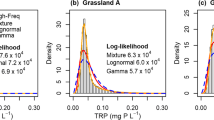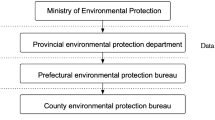Abstract
Total coliforms are used as indicators for evaluating microbial water quality in distribution networks. However, total coliform provides only a weak “evidence” of possible fecal contamination because pathogens are subset of total coliform and therefore their presence in drinking water is not necessarily associated with fecal contamination. Heterotrophic plate counts are also commonly used to evaluate microbial water quality in the distribution networks, but they cover even a wider range of organisms. As a result, both of these indicators can provide incomplete and highly uncertain bodies of evidence when used individually. In this paper, it is shown that combing these two sources of information by an appropriate data fusion technique can provide improved insight into microbial water quality within distribution networks. Approximate reasoning methods like fuzzy logic and probabilistic reasoning are commonly used for data fusion where knowledge is uncertain (i.e., ambiguous, incomplete, and/or vague). Traditional probabilistic frameworks like Bayesian analysis, reasons through conditioning based on prior probabilities (which are hardly ever available). The Dempster–Shafer (DS) theory generalizes the Bayesian analysis without requiring prior probabilities. The DS theory can efficiently deal with the difficulties related to the interpretation of overall water quality where the redundancy of information is routinely observed and the credibility of available data continuously changes. In this paper, the DS rule of combination and its modifications including Yager’s modified rule, Dubois–Prade disjunctive rule and Dezert–Smarandache rule are described using an example of microbial water quality in a distribution network.



Similar content being viewed by others
References
Alim S (1988) Application of Dempster–Shafer theory for interpretation of seismic parameters. ASCE J Struct Eng 114(9):2070–2084
Attoh-Okine NO, Gibbons J (2001) Use of belief function in brownfield infrastructure redevelopment decision making. ASCE J Urban Plan Dev 127(3):126–143
Bartram J, Cotruvo J, Exner M, Fricker C, Glasmacher A (2003) Heterotrophic plate counts and drinking water safety, the significance of HPCs for water quality and human health. WHO, Geneva
Binaghi E, Luzi L, Madella P, Pergalani F, Rampini A (1998) Slope instability zonation: a comparison between certainty factor and fuzzy Dempster–Shafer approaches. Nat Hazards 17:77–97
Bonissone PP (1997) Soft computing: the convergence of emerging reasoning technologies. Soft Comput 1:6–18
Boyd M, Walley WJ, Hawkes HA (1993) Dempster–Shafer reasoning for the biological surveillance of river water quality, Water Pollution 93. Milan, Italy
Chang YC, Wright JR (1996) Evidential reasoning for assessing environmental impact. Civil Eng Syst 14(1):55–77
Demotier S, Schon W, Denoeux T (2006) Risk assessment based on weak information using belief functions: a case study in water treatment. IEEE Trans Syst Man Cybern—Part C: Appl Rev (in press)
Dempster A (1967) Upper and lower probabilities induced by a multi-valued mapping. Ann Stat 28:325–339
Dezert J, Smarandache F (2004) Presentation of DSmT. Chapter 1 in advances and applications of DSmT for information fusion (collected works). American Research Press, Rehoboth, pp 3–35
Dubois D, Prade H (1992) On the combination of evidence in various mathematical frameworks. In: Flamm J, Luisi T (eds) Reliability data collection and analysis. Brussels, ECSE, EEC, EAFC, pp 213–241
Halpern JY, Fagin R (1992) Two views of belief: belief as generalized probability and belief as evidence. Artif Intell 54:275–317
Inagaki T (1991) Interdependence between safety-control policy and multiple sensor scheme via Dempster–Shafer theory. IEEE Trans Reliab 40(2):182–188
Kholas J, Monney P-D (1995) A mathematical theory of hints—an approach to Dempster–Shafer theory of evidence. Lecture notes in economics and mathematical systems 425. Springer, Berlin Heidelberg New York
Klir JG (1995) Principles of uncertainty: what are they? why do we need them? Fuzzy Set Syst 74:15–31
Liou Y-T, Lo S-L (2005) A fuzzy index model for trophic status evaluation of reservoir waters. Water Res 39(7):1415–1423
Luo WB, Caselton B (1997) Using Dempster–Shafer theory to represent climate change uncertainties. J Environ Manage 49(1):73–93
Murphy CK (2000) Combining belief functions when evidence conflicts. Decis Support Syst 29:1–9
Najjaran H, Sadiq R, Rajani B (2005) Condition assessment of water mains using fuzzy evidential reasoning. In: 2005 IEEE international conference on systems, man, and cybernetics, Hawaii, USA, October 2005
Sadiq R, Rodriguez MJ (2005) Predicting water quality in the distribution system using evidential theory. Chemosphere 59(2):177–188
Sadiq R, Kleiner Y, Rajani B (2006) Estimating risk of contaminant intrusion in water distribution networks using Dempster–Shafer theory of evidence. Civil Eng Environ Syst (in press)
Sentz K, Ferson S (2002) Combination of evidence in Dempster–Shafer theory. SAND 2002–0835
Shafer G (1976) A mathematical theory of evidence. Princeton University Press, Princeton, NJ
Smets P (1990) The combination of evidence in the transferable belief model. IEEE Trans Pattern Anal Mach Intell 12(5):447–458
Sönmez M, Holt GD, Yang JB, Graham G (2002) Applying evidential reasoning to prequalifying construction contractors. ASCE J Manage Eng 18(3):111–119
Tanaka K, Klir GJ (1999) Design condition for incorporating human judgement into monitoring systems. Reliab Eng Syst Safe 65:251–258
Wang Y, Civco DL (1994) Evidential reasoning-based classification of multi-source spatial data for improved land cover mapping. Can J Remote Sens 20:381–395
World Health Organization (WHO) (2004) Safe piped water: managing microbial water quality in piped distribution systems. In: Ainsworth R (ed) Published on behalf of the by IWA Publishing
Yager RR (1987) On the Dempster–Shafer framework and new combination rules. Inform Sci 41:93–137
Yager RR (2004) On the determination of strength of belief for decision support under uncertainty. Part II. Fusing strengths of belief. Fuzzy Set Syst 142:129–142
Yang J-B, Xu D-L (2002) On the evidential reasoning algorithm of multiple attribute decision analysis under uncertainty. IEEE Trans Syst Man Cybern A: Syst Hum 32(3):289–304
Zadeh LA (1984) Review of books: a mathematical theory of evidence. AI Mag 5(3):81–83
Zhang L (1994) Representation, independence, and combination of evidence in the Dempster–Shafer theory. In: Yager RR, Kacprzyk J, Fedrizzi M (eds) Advances in Dempster–Shafer theory of evidence. Wiley, New York, pp 51–69
Author information
Authors and Affiliations
Corresponding author
Rights and permissions
About this article
Cite this article
Sadiq, R., Najjaran, H. & Kleiner, Y. Investigating evidential reasoning for the interpretation of microbial water quality in a distribution network. Stoch Environ Res Ris Assess 21, 63–73 (2006). https://doi.org/10.1007/s00477-006-0044-7
Published:
Issue Date:
DOI: https://doi.org/10.1007/s00477-006-0044-7




